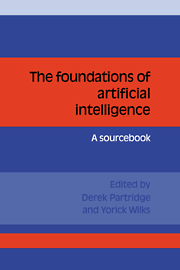Book contents
- Frontmatter
- Contents
- List of contributors
- Preface
- Acknowledgments
- 1 Introduction
- What is AI anyway?
- What kind of information processing is intelligence?
- 2 The formal foundations of AI
- 3 Levels of theory
- 4 Programs and theories
- 5 The role of representations
- 6 The role of programs in AI
- 7 Rational reconstruction as an AI methodology
- 8 Is AI special in regard to its methodology?
- 9 Does connectionism provide a new paradigm for AI?
- 10 The role of correctness in AI
- 11 Limitations on current AI technology
- 12 Annotated bibliography on the foundations of AI
- Index of names
What kind of information processing is intelligence?
Published online by Cambridge University Press: 03 May 2010
- Frontmatter
- Contents
- List of contributors
- Preface
- Acknowledgments
- 1 Introduction
- What is AI anyway?
- What kind of information processing is intelligence?
- 2 The formal foundations of AI
- 3 Levels of theory
- 4 Programs and theories
- 5 The role of representations
- 6 The role of programs in AI
- 7 Rational reconstruction as an AI methodology
- 8 Is AI special in regard to its methodology?
- 9 Does connectionism provide a new paradigm for AI?
- 10 The role of correctness in AI
- 11 Limitations on current AI technology
- 12 Annotated bibliography on the foundations of AI
- Index of names
Summary
AI as science of intelligence
Paradigmatic confusion in AI. In spite of what I regard as AI's significant achievements in beginning to provide a computational language to talk about the nature of intelligence, the not so well-kept secret is that AI is internally in a paradigmatic mess. There is really no broad agreement on the essential nature or formal basis of intelligence and the proper theoretical framework for it.
Intelligence as information processing on representations
Let us first seek some unities. There is something that is shared almost universally among workers in AI: “Significant (all?) aspects of cognition and perception are best understood/modeled as information processing activities on representations.” The dominant tradition within AI has been the symbolic paradigm. On the other hand, modern connectionists (and the earlier perceptron theorists) offer largely analog processes implemented by weights of connections in a network. Stronger versions of the symbolic paradigm have been proposed by Newell as the physical symbol system hypothesis (Newell, 1980), and elaborated by Pylyshyn (1984) in his thesis that computation is not simply a metaphorical language to talk about cognition, but that cognition is literally computation over symbol systems. It is important to emphasize that this thesis does not imply a belief in the practical sufficiency of current von Neuman computers for the task, or a restriction to serial computation. Often, disagreements with the symbolic paradigm turn out to be arguments for parallel computers of some type, rather than arguments against computations on discrete symbolic representations.
- Type
- Chapter
- Information
- The Foundations of Artificial IntelligenceA Sourcebook, pp. 14 - 46Publisher: Cambridge University PressPrint publication year: 1990
- 21
- Cited by

